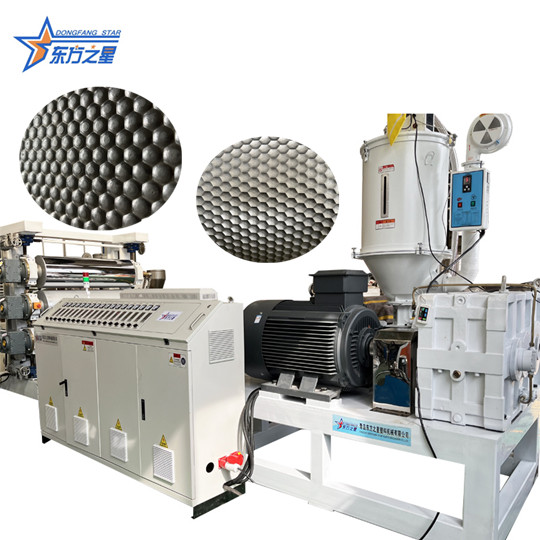Introduction to the Working Principle of Sheet Extruder Machine
2024-12-19
A sheet extruder machine is a specialized piece of equipment used in the manufacturing of plastic sheets, which are commonly used in a variety of industries, including packaging, construction, automotive, and electronics. The machine takes raw polymer materials, melts them, and then forms them into sheets of consistent thickness and width. These sheets can be further processed or directly used for various applications, depending on the desired end product.
Understanding how the sheet extruder machine works can help in optimizing production processes, ensuring product quality, and troubleshooting any issues that may arise. In this blog, we’ll dive into the working principle of a sheet extruder machine, exploring its key components and the steps involved in the extrusion process.
Key Components of a Sheet Extruder Machine
Before delving into the working principle, it’s essential to familiarize yourself with the key components of a sheet extruder machine:
1. Extruder Barrel and Screw: The heart of the extrusion process, where the raw material is melted and homogenized.
2. Heaters: These are used to heat the material to its melting point before it is forced through the die.
3. Die Head: This part shapes the melted plastic into a continuous sheet.
4. Cooling System: After the material exits the die, it must be cooled rapidly to solidify and maintain its shape.
5. Calibration and Sizing Unit: Ensures the sheet's thickness and width are consistent by applying controlled pressure and cooling.
6. Roller System: Used to stretch, smooth, and further cool the sheet after it leaves the calibration unit.
7. Take-Off Unit: Pulls the finished sheet from the extruder and feeds it onto a winding system or cutting station for further processing.

Working Principle of a Sheet Extruder Machine
The working principle of a sheet extruder machine can be divided into several stages:
1. Material Feeding
- Raw Materials (such as plastic pellets, powders, or regrind material) are loaded into the extruder’s feed hopper. The materials can be a variety of thermoplastic polymers, such as PVC, PET, PS, or ABS, depending on the application.
2. Melting and Homogenization
- Once the material enters the extruder barrel, it is moved by the rotating screw. As the screw turns, it applies both mechanical shear force and heat (provided by the heaters surrounding the barrel) to melt the material.
- The material undergoes a plasticization process, where it is uniformly mixed and melted into a homogeneous, molten state. The rotating screw not only melts the plastic but also forces it towards the die, ensuring consistent flow.
3. Extrusion through the Die
- The molten plastic is forced through the die head at the end of the extruder. The die has an opening shaped like the desired sheet’s cross-section.
- The size and shape of the die determine the thickness and width of the extruded sheet. The die gap (the space between the die lips) is precisely adjusted to control the final sheet thickness.
4. Cooling and Solidification
- After the molten plastic is extruded through the die, it enters a cooling zone to solidify. Cooling is typically achieved through air cooling or water bath cooling, depending on the material and the desired cooling rate.
- Cooling units or calibration plates are used to ensure that the sheet maintains its correct dimensions and shape as it hardens.
5. Sizing and Calibration
- The calibration and sizing unit ensures the extruded sheet meets the required specifications. It applies precise pressure and temperature control to maintain the desired thickness and width.
- If necessary, rollers can further stretch or smooth the sheet to improve its surface quality and ensure uniformity across its entire length.
6. Winding or Cutting
- After the sheet has cooled and been properly calibrated, it is pulled through a series of rollers that may stretch it to a specific length or width.
- The final product is then either wound onto a roll for storage or sent to a cutting station for specific sheet lengths.
- The sheet can also undergo additional processes, such as embossing, printing, or lamination, depending on the application.
Advantages of Sheet Extruder Machines
- Precision Control: The process allows for accurate control over the sheet’s thickness, width, and surface quality.
- Versatility: Sheet extruders can handle a wide variety of raw materials and can be customized to produce different types of sheets for specific applications.
- Efficiency: The continuous extrusion process reduces waste and increases production efficiency, making it ideal for high-volume production runs.
- Customization: Various configurations, such as multi-layer extrusion, can be used to create sheets with different material properties (e.g., barrier layers, surface coatings).
Applications of Sheet Extruder Machines
The products created by sheet extruder machines are used in a wide array of industries, including:
- Packaging: Films and sheets for food packaging, medical supplies, and consumer goods.
- Construction: Sheets for building materials, including PVC siding, flooring, and roofing materials.
- Automotive: Production of interior and exterior plastic components.
- Electronics: Sheets for protective covers and packaging for electronics.
- Signage and Advertising: Printed plastic sheets for signs, banners, and displays.
Conclusion
The sheet extruder machine is a critical piece of equipment in the plastics manufacturing industry, enabling the production of high-quality plastic sheets used across numerous sectors. Its working principle involves a precise, multi-step process of feeding, melting, shaping, cooling, and calibrating plastic materials into finished sheets. By understanding the key components and principles behind sheet extrusion, manufacturers can optimize production, improve product quality, and enhance efficiency.


